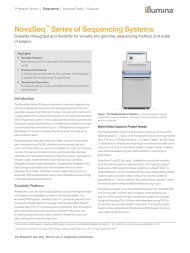Abstracts
ngsfinalprogram
ngsfinalprogram
You also want an ePaper? Increase the reach of your titles
YUMPU automatically turns print PDFs into web optimized ePapers that Google loves.
Poster <strong>Abstracts</strong><br />
that resolved clinical strains of K. pneumoniae<br />
prior to whole genome sequencing. Clinical<br />
isolates with distinct Resistome Test results<br />
were shown to be distinct strains by whole<br />
genome sequencing while isolates with identical<br />
Resistome Test results were often identical<br />
strains by whole genome sequencing. The Resistome<br />
Test was able to resolve 40% of the 65<br />
isolates as distinct strains, thereby identifying<br />
two potential groups of strain types for higher<br />
resolution by whole genome sequencing. We<br />
concluded that Acuitas ® Resistome Test is useful<br />
for detecting carbapenem and cephalosporin<br />
resistance in Gram-negative bacilli and as<br />
a triage tool to select culture isolates for strain<br />
typing by WGS.<br />
n 35<br />
PATHOGEN DISCOVERY IN TRAVELERS’<br />
DIARRHEA OF UNKNOWN ETIOLOGY BY<br />
METAGENOMIC SEQUENCING<br />
Q. Zhu, M. Jones, S. Highlander;<br />
J. Craig Venter Institute, La Jolla, CA.<br />
Infectious diarrhea is responsible for about<br />
million deaths each year. We are studying<br />
travelers’ diarrhea (TD) where the known<br />
causative agents are members of Enterobacteriaceae,<br />
such as enterotoxigenic Escherichia<br />
coli, Shigella and Salmonella, viruses such<br />
as norovirus, and parasites such as Giardia.<br />
Nevertheless, in over 40% of cases, a known<br />
pathogen cannot be identified by traditional<br />
clinical tests. “Pathogen negative” diarrhea is<br />
enigmatic, although this due, in part to a lack<br />
of appropriate cultivation and screening tests<br />
and poor sensitivity of the tests. DNA sequencing<br />
is increasingly being applied in attempts to<br />
characterize agents of infectious disease. We<br />
hypothesize that unrecognized pathogens are<br />
responsible for a significant proportion of TD.<br />
These may be known organisms with unrecognized<br />
pathogenic potential or may be completely<br />
new species with new mechanisms of<br />
virulence. We have performed deep NextSeq<br />
paired-end sequencing of DNAs from stools of<br />
eight pathogen-negative and two healthy traveler<br />
controls in an attempt to identify pathogens.<br />
A total of 132.8 Gb (ca. 12-20 Gb raw<br />
data/sample) of sequencing data were retained<br />
after quality filtering. Reads were mapped to<br />
the NCBI RefSeq genomic database, resulting<br />
in an average mapping rate of 72.4% (min:<br />
33.1%, max: 93.8%). In the samples where<br />
mapping was low, we believe that many of<br />
the unmapped reads likely represent new uncharacterized<br />
organisms. Taxonomic profiles<br />
were generated based on the mapping results,<br />
and revealed significantly uneven distribution<br />
of microbial groups among samples. The low<br />
complexity samples appear to be dominated by<br />
a single pathogen, while the high complexity<br />
samples may be the result of a mixed etiology.<br />
Three TD samples are enriched for E. coli sequences,<br />
despite the fact that enterotoxins were<br />
not detected in clinical screens. Two of these<br />
carry genes for the Shiga toxin. Additional<br />
TD samples had, for example, high abundance<br />
of Akkermansia muciniphila, Streptococcus<br />
spp., Campylobacter jejuni, or Alistipes shahii<br />
reads, while the two healthy traveler controls<br />
had high abundance of reads that mapped to<br />
several Bifidobacterium species, which were<br />
not present in the diarrheal samples. De novo<br />
assembly was performed for each sample<br />
(average N50 statistic: 6516.4), followed by<br />
contig binning and scaffolding. Near complete<br />
draft genomes were successfully recovered<br />
from the metagenomes. Some represent known<br />
species (such as E. coli and Campylobacter),<br />
while others could not be taxonomically placed<br />
in proximity to any known bacterial groups.<br />
Our results provide a glimpse into the microbiome<br />
diversity composition and potential etiological<br />
sources in “no pathogen identified” TD<br />
samples, and demonstrate the power of highthroughput<br />
DNA sequencing in the discovery<br />
of pathogens in infectious disease.<br />
ASM Conference on Rapid Next-Generation Sequencing and Bioinformatic<br />
Pipelines for Enhanced Molecular Epidemiologic Investigation of Pathogens<br />
63



